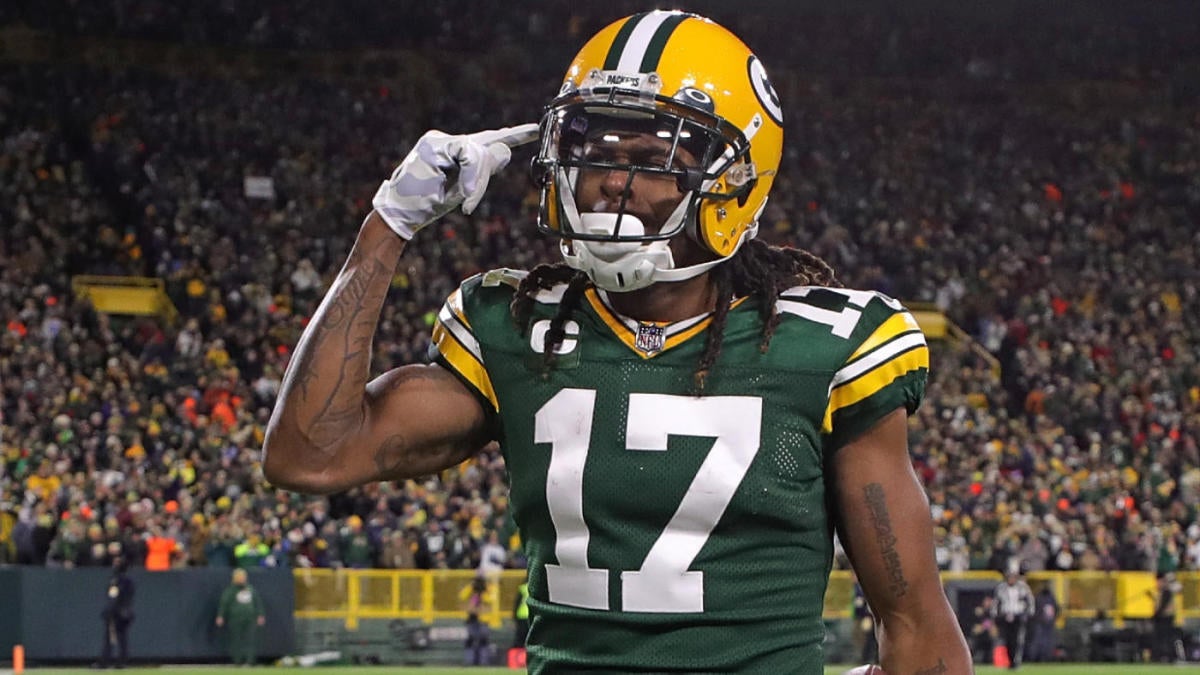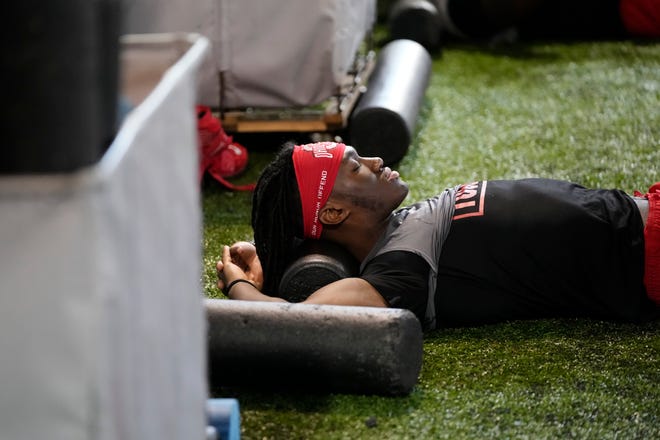Table of Contents
Packers general manager Brian Gutekunst referred to using a franchise tag on Davante Adams as a last resort last week when meeting with the local Green Bay media. The All-Pro wide receiver is exactly the type of player that typically gets franchised, although the last time the Packers used the designation was in 2010 on defensive tackle Ryan Pickett.
Adams is the NFL’s most productive wide receiver since signing his expiring four-year contract extension at the end of the 2017 season. He leads the NFL in receptions (432), receiving yards (5,310) and touchdown catches (47) during this span. Adams set the Packers single season record for receiving yardage with 1,553 yards in 2021. He also had 123 catches to break his own team record along with 11 receiving touchdowns.
The Packers have less than a week to avoid the last resort scenario. The deadline for NFL teams to designate a franchise player is 4 p.m. ET on March 8. Gutekunst indicated there’s been “constant communication” with Adams and his representatives during his media session on Tuesday at the NFL Scouting Combine in Indianapolis.
The Packers already have a challenging salary cap situation without a $20.12 million franchise tag for Adams. After entering the offseason approximately $50 million over the projected $208.2 million 2022 salary cap, the Packers have started decreasing the overage by restructuring multiple contracts (tackle David Bakhtiari, defensive tackle Kenny Clark, running back Aaron Jones). The overage doesn’t factor in Adams’ franchise tag. The $20.12 million would become a Green Bay salary cap charge as soon as the designation is made.
Could the Packers and Adams reach a long-term deal?
The Packers and Adams weren’t close to reaching an agreement during negotiations last offseason. Adams wanted to replace DeAndre Hopkins as the NFL’s highest paid wide receiver. The Packers weren’t willing to acknowledge the $27.25 million per year new money average for the two-year extension Hopkins received from the Cardinals in 2020 because he had three years remaining when he signed. The Hopkins deal is an outlier in the wide receiver market. Titans wide receiver Julio Jones is second at the position on the three-year extension he signed with the Falcons in 2019 averaging $22 million per year.
Shortly after the Packers were eliminated in the divisional playoffs by the 49ers, reports of Adams wanting $30 million per year on a new contract, which is extremely ambitious, surfaced. Steelers edge rusher T.J. Watt, 2021’s NFL Defensive Player of the Year, is the league’s highest paid non-quarterback at $28,002,750 per year.
A long-term deal would be beneficial for the Packers from a salary cap standpoint. Adams’ 2022 cap number could easily be less than half of his franchise tag.
An Adams deal might need to set a new standard for a signing bonus with non-quarterbacks. Rams perennial All-Pro defensive tackle Aaron Donald currently holds mark at $40 million. For example, Adams signing a five-year deal with a $42.5 million signing bonus and a $1.25 million 2022 salary would have a $9.75 million 2022 cap number.
A favorable cash flow would likely also be a necessity because of how Green Bay structures veteran contracts. The only guaranteed money in Green Bay deals is a signing bonus. The lone exception is quarterback Aaron Rodgers, whose deals have conventional contract guarantees. The bigger deals contain third or fifth day of the league year roster bonuses in the second and third years. The roster bonuses are supposed to be substitutes for additional contract guarantees. The overall guarantees in Green Bay contracts are usually less than comparable deals on other teams.
How Rodgers’ decision affects Adams
An important piece of the puzzle is Rodgers’ upcoming decision about his football future. Rodgers has suggested that he will decide whether he wants to remain in Green Bay, seek a trade or retire before the 15 day franchise player designation period ends to be sensitive to Adams’ situation. The Packers and Rodgers’ camp reportedly are having discussions about a short-term extension that will make Rodgers the NFL’s highest paid player should he want to continue playing in Green Bay. Rodgers becoming the league’s first $50 million per year player wouldn’t be a surprise.
Gutekunst called the Rodgers decision and an Adams franchise tag separate situations in Tuesday’s address to the media. That may not be a fair characterization. Rodgers committing to the Packers beyond the 2022 season when his contract is set to expire should give Adams more leverage in negotiations. In order to keep Rodgers in the fold, assurances that Adams will be in Green Bay at least as long as any extension he signs probably needed to be made.
Adams made it clear last offseason that a Rodgers departure would impact his own decisions about his career. He reiterated this stance near the end of the regular season. As a former agent, my interpretation of Adams’ comments is the Packers will need to pay him a premium if he is going to be catching passes on a go forward basis from 2020 first round pick Jordan Love, an unproven commodity, instead of the winner of the last two NFL MVP awards.
Adams should try to avoid at almost all costs playing under a franchise tag without Rodgers throwing to him. Allen Robinson is a cautionary tale for a franchise player having an inexperienced quarterback. He thrived with the Bears before 2021 11th overall pick Justin Fields’ arrival. Robinson had the NFL’s fourth most receptions (200) and receiving yards (2,397) over the 2019 and 2020 seasons.
2021 was Robinson’s worst NFL season (other than 2017 when he tore his left ACL in the Jaguars season opener). Robinson had 36 catches for 410 yards with one touchdown in 12 games, which can partially be attributed to a lack of chemistry with Fields. One thing Robinson doesn’t have to worry about is a second consecutive franchise tag because it will cost the Bears $21.556 million.
Some sort of statistical drop-off for Adams, who turns 30 in December, would seem inevitable with a new quarterback. Age and a decline in production would likely be held against Adams if he hit the open market in 2023 under these circumstances.
Could Adams be traded?
It’s hard to imagine the Packers letting Adams leave in free agency this year for just a 2023 third round compensatory draft pick at best because of the additional cap issues with the franchise tag if Rodgers isn’t a part of the equation. Franchising Adams and trading him would make more sense.
The return for Adams in a trade should greatly exceed any compensatory pick. The Texans sent shockwaves through the NFL in March 2020 by trading Hopkins and a 2020 fourth round pick to the Cardinals in exchange for running back David Johnson, a 2020 second round pick and a 2021 fourth round pick. The general consensus around the NFL was the Texans got fleeced by the Cardinals.
The draft capital the Vikings received for wide receiver Stefon Diggs may be more indicative of what the Packers could get for Adams. The Bills gave up a 2020 first round pick, a 2020 fifth round pick, a 2020 sixth round and a 2021 fourth round pick to get Diggs and a 2020 seventh round pick hours after Hopkins was dealt.





